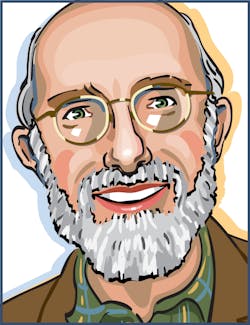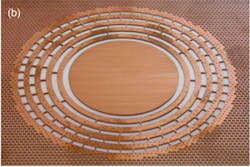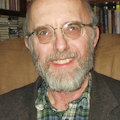
We think of metamaterials as designed specifically to manipulate light and other electromagnetic radiation. Yet metamaterials can also go beyond optics to manipulate other types of waves, flows of heat, or diffusion of materials through a fluid. Martin Wegener of the University of Karlsruhe (Karlsruhe, Germany) outlined the idea in a recent perspective in Science, and with three colleagues gives a detailed review in the New Journal of Physics.
Acoustic metamaterials don't require nanostructures because sound waves are long compared to light. A 100 Hz sound wave in air at 20°C is 3.43 m and a 10,000 Hz wave on the high end is 3.43 cm, so the building blocks for audio-frequency waves can be centimeter-scale. The speed of sound in a material, and thus how it refracts light waves, depends on its stiffness and lightness, giving considerable latitude for engineering. Cloaking is easier for sound than for light because cloaking depends on diverting waves on a longer path around an object, and acoustic materials can be designed to conduct sound faster than it can go through air for a broad range of frequencies. Because of the rigid limit on the speed of light, optical cloaking only works in a narrow band.
Acoustic cloaking also is possible in water, where a stealth-like cloak could hide submarines, an idea of doubtless appeal to the Navy. The biggest potential application of such vibrational cloaking could be in seismology. A recent experiment in France showed that an array of holes drilled in the ground under a vulnerable structure could shield it from seismic waves; a paper is to appear in the February 25, 2014 issue of Physical Review Letters. The array also resembles a photonic crystal.Similarly, structured metamaterials also can direct the flow of heat. Naturally heat diffuses isotropically through a solid, but internal structures can slow or redirect the flow, says Sebastien Guenneau of the Fresnel Institute (Marseilles, France). His group cut an array of ring-shaped slices from the a conductive metal sheet, leaving only thin bridges connecting the region inside them to the rest of the sheet (see figure). An insulator is put inside the openings. That structure slows heating from reaching the central region, and—because heat flows rapidly across solid areas, but much more slowly through the rings—keeps the central region at a uniform temperature. That's important for electronic devices, which can be damaged by temperature gradients. Similar concepts can be used to slow molecular diffusion within a fluid.
It's intriguing to see how a concept first developed for optics can be applied to other fields. And, likewise, we should recall that optics can borrow ideas from other fields as well.
About the Author
Jeff Hecht
Contributing Editor
Jeff Hecht is a regular contributing editor to Laser Focus World and has been covering the laser industry for 35 years. A prolific book author, Jeff's published works include “Understanding Fiber Optics,” “Understanding Lasers,” “The Laser Guidebook,” and “Beam Weapons: The Next Arms Race.” He also has written books on the histories of lasers and fiber optics, including “City of Light: The Story of Fiber Optics,” and “Beam: The Race to Make the Laser.” Find out more at jeffhecht.com.

